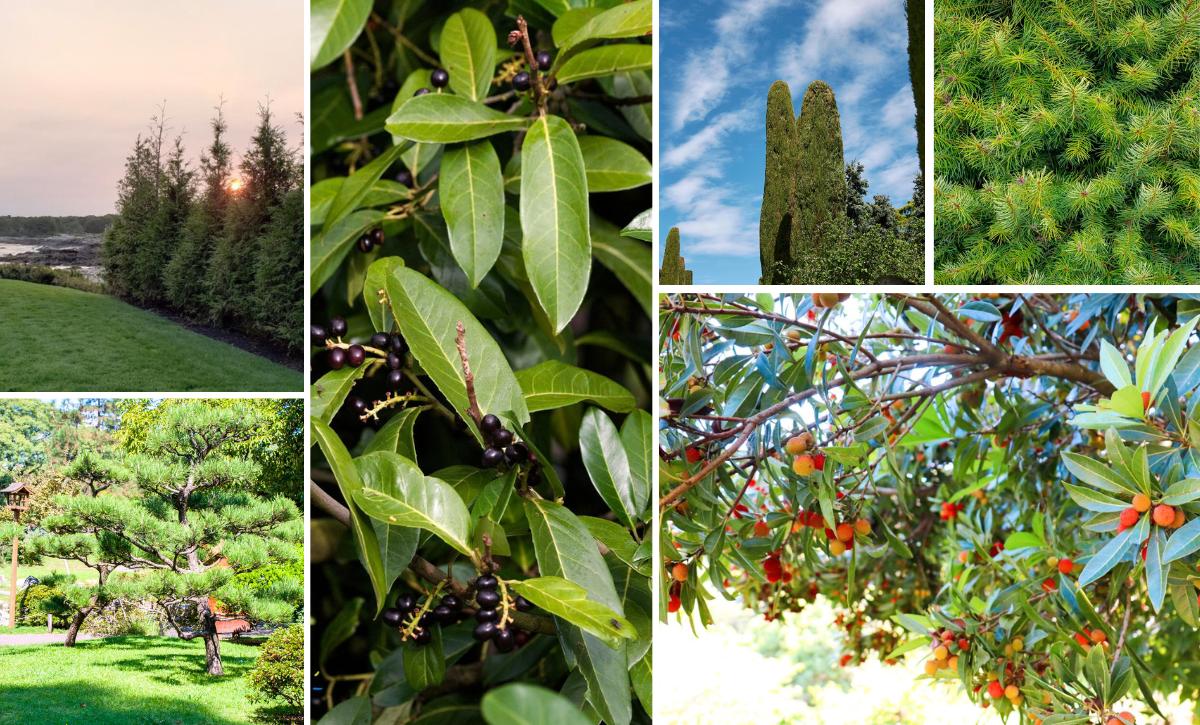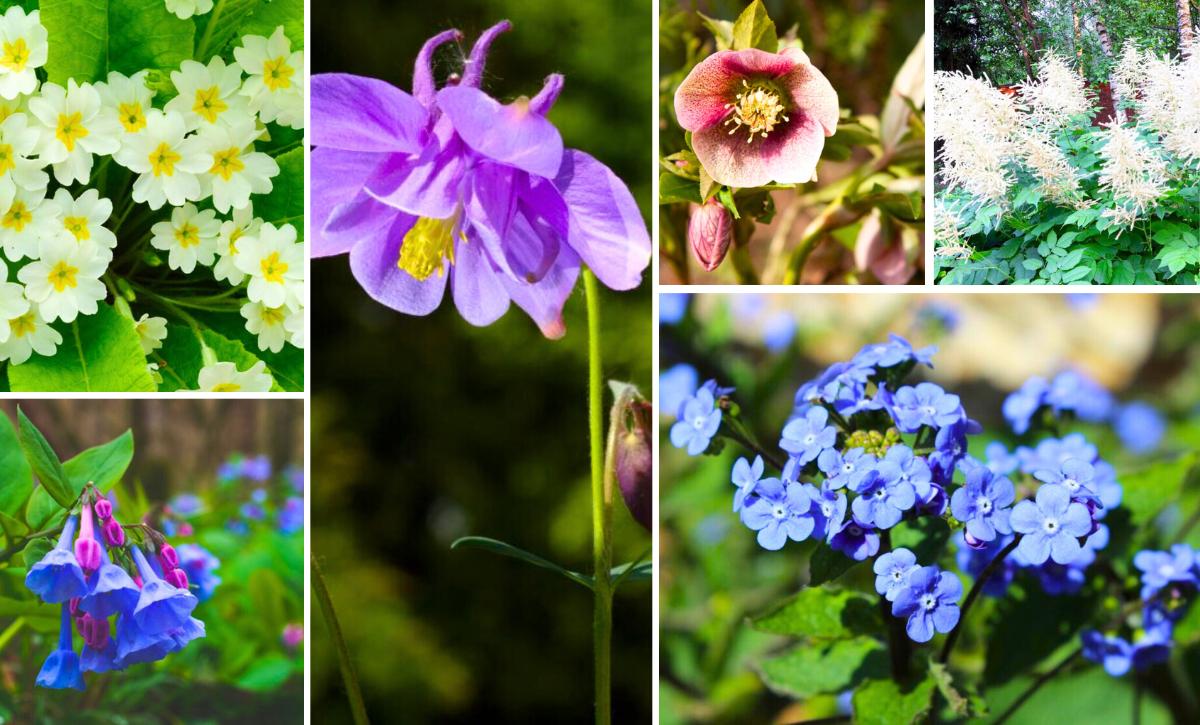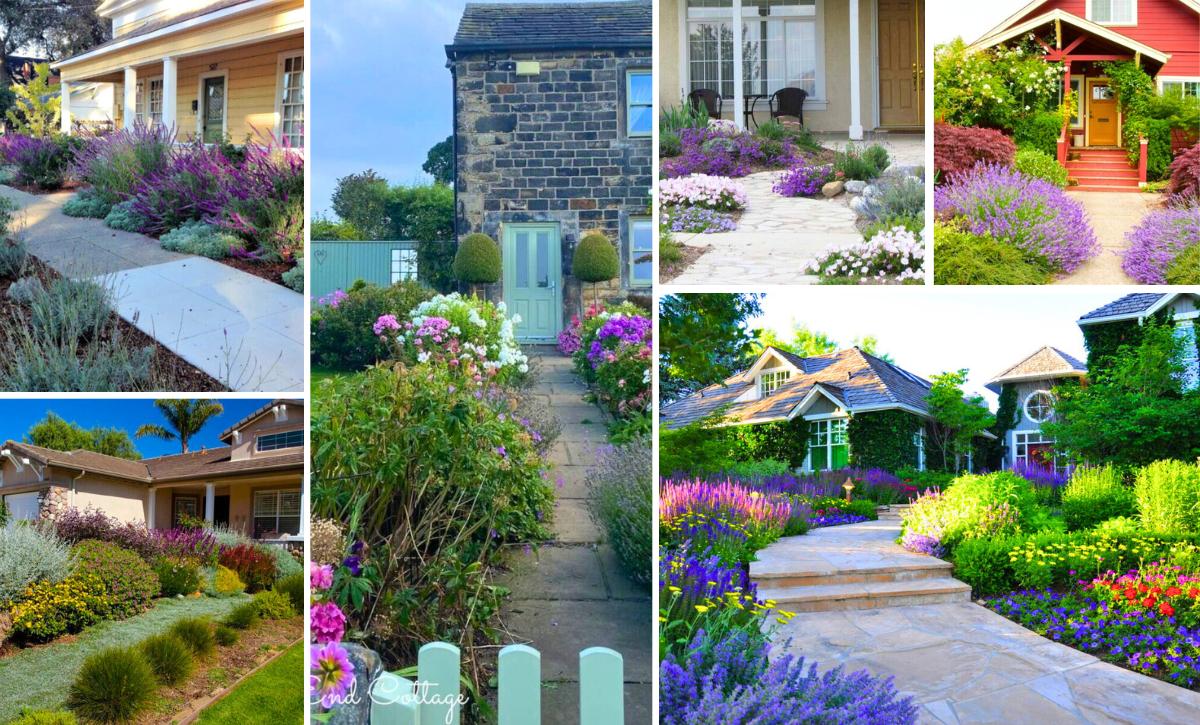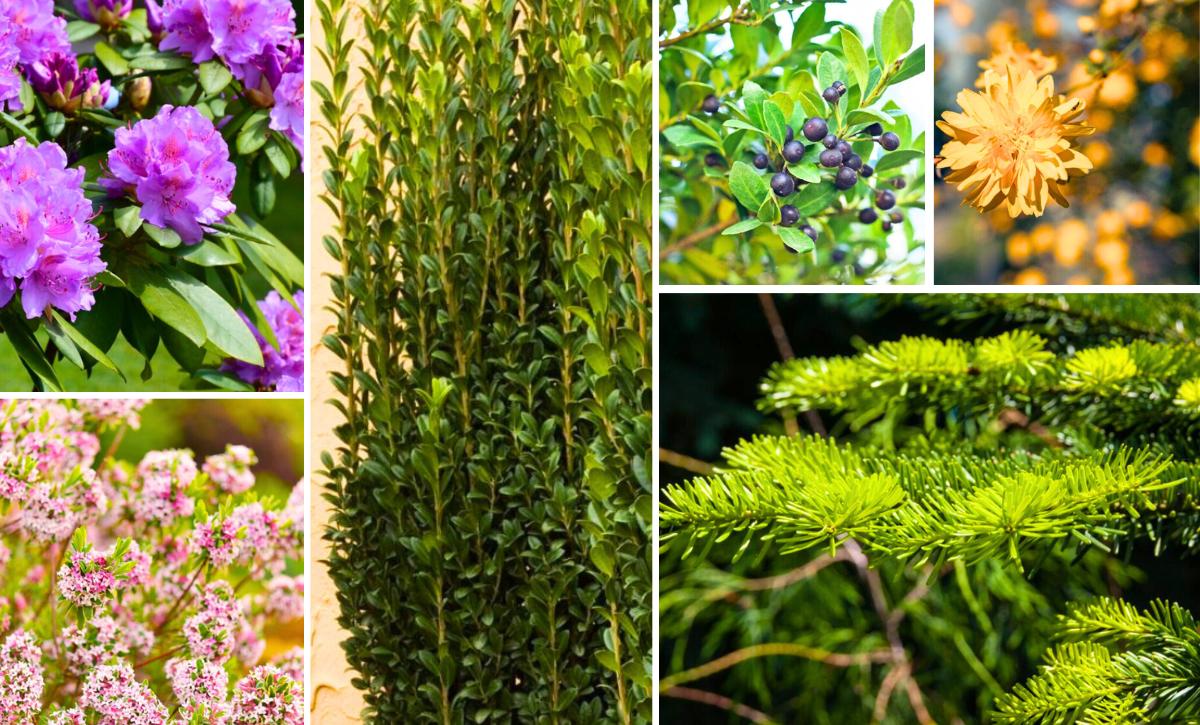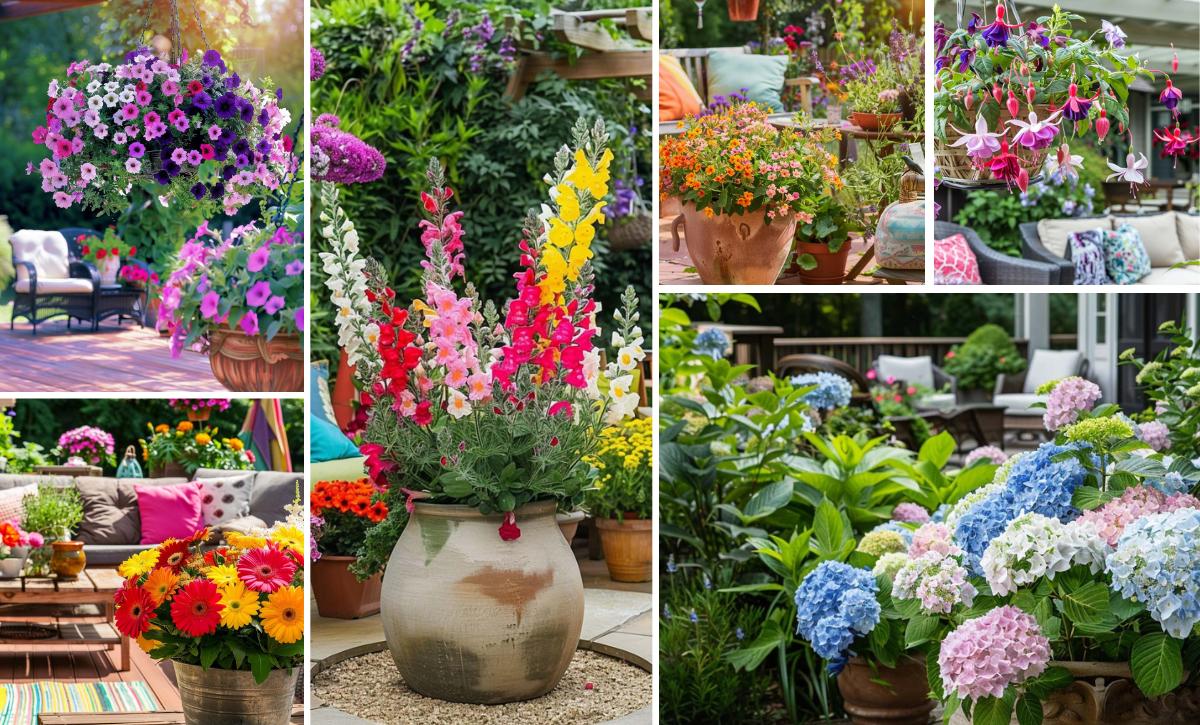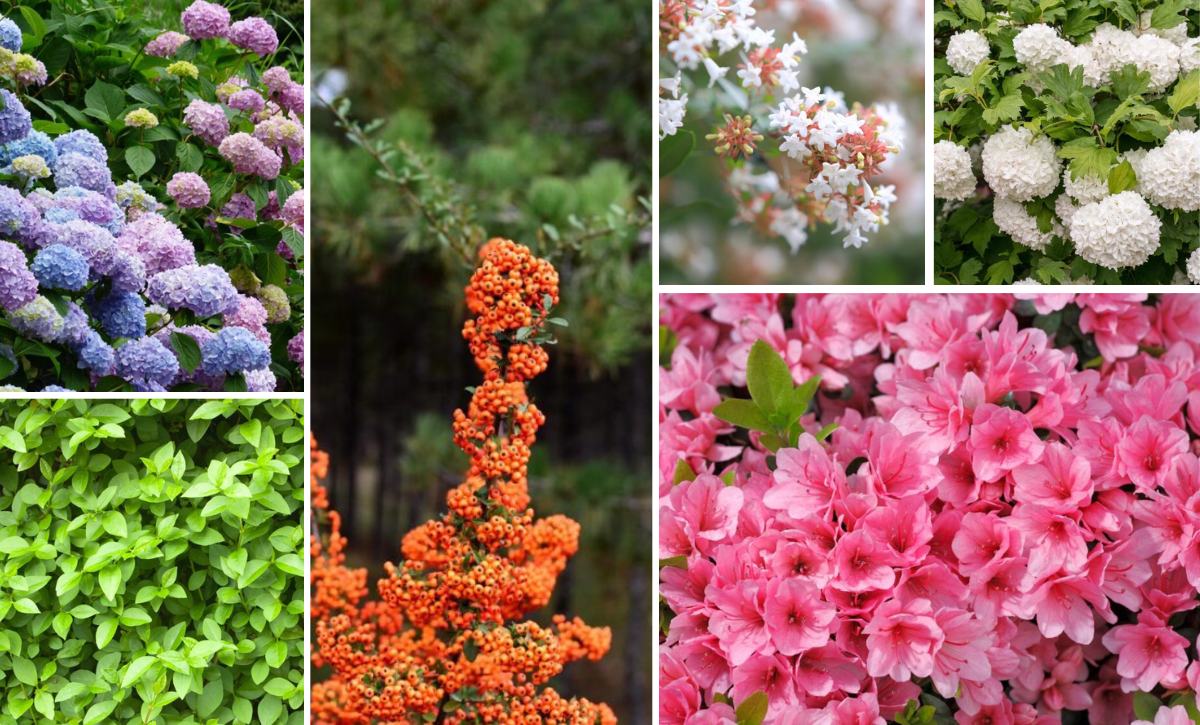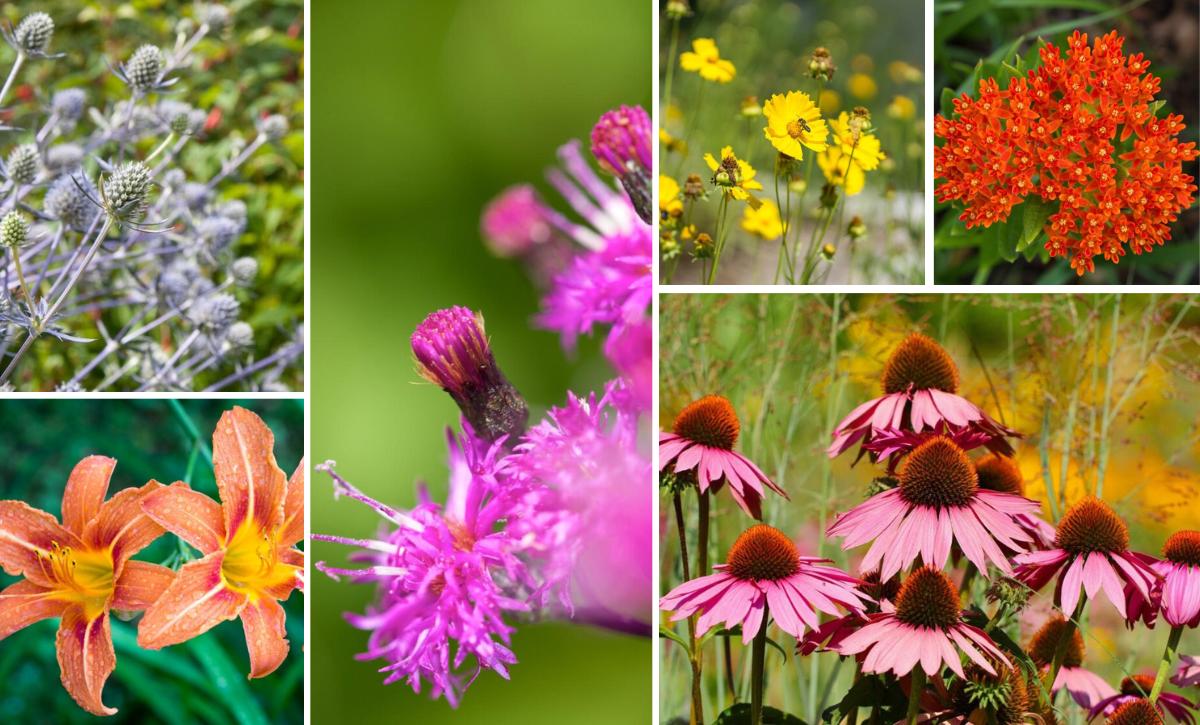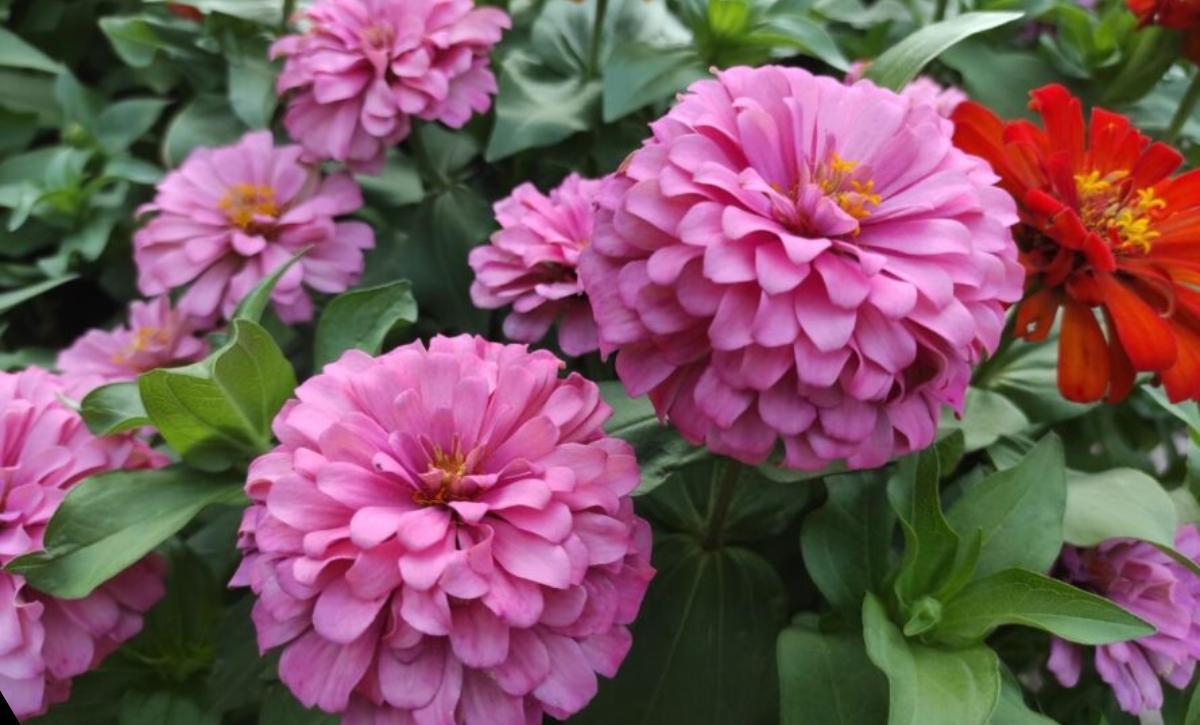Vegetable gardens don’t explicitly mean that you should only grow vegetables on them. Sometimes, adding some flowers will elevate the look of your garden.
They can also act as good companion plants, helping deter pests and attracting pollinators. Interplanting can also help you save time and space as you grow various plants in one place.
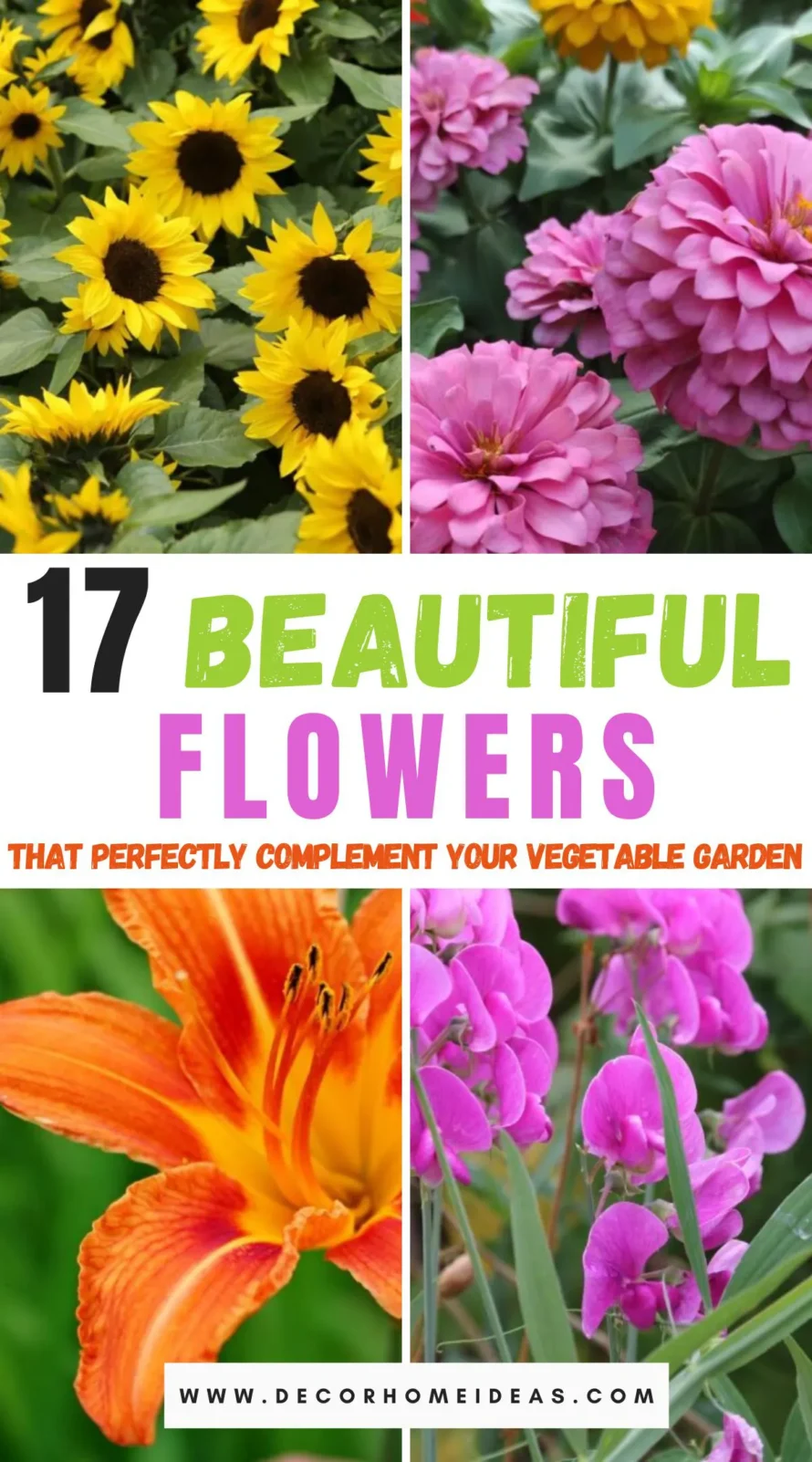
Besides companion benefits, a vegetable garden is also the perfect place to grow flowers you intend to cut and use for your vases indoors or for other decorative purposes. You can snip them as you harvest your vegetables.
Here are 17 flowers you can add to your garden to give it a new look and dimension.
Take a look!
Why Add Flowers to Your Vegetable Garden?
Planting flowers in your vegetable garden isn’t a strategy to add an aesthetic component to the space; it can also help your plants increase produce and help your vegetables thrive.
The only tricky part about combining these crops is that you may have to experiment with various plants to see which works better with your vegetables. Here are some of the symbiotic relationships that could be beneficial to your garden:
Attracting beneficial insects: Insects like ladybugs are natural predators of many pests that attack crops, and growing flowers like zinnias is one way to attract them.
Improving soil: Drainage and nutrient supply are crucial components of soil, and growing flowers such as lupine may increase nitrogen supply and improve drainage.
Attracting pollinators: Attracting pollinators may encourage your vegetables to grow and promote fruit formation. Flowers like alyssum, zinnias, and cosmos attract pollinators such as bees, which help spread pollen and encourage vegetable growth.
Preventing predators: Flowers can discourage predators, not just pests. Growing flowers like lavenders along garden borders can discourage pests like mosquitos and predators like mice. You can also plant sunflowers to deter raccoons.
Repelling and trapping pests: Keeping pests away is crucial to a healthy garden. Flowers like marigolds and petunias can help keep pests at bay. Nasturtiums and marigolds may lure in harmful pests like aphids, keeping them away from your vegetables.
Improving the aesthetics: Of course, elevating the appearance of your garden is one of the main reasons you should plant flowers. Flowers make everything beautiful, colorful, and generally more attractive.
Flowers to Complement a Vegetable Garden
1. Zinnia
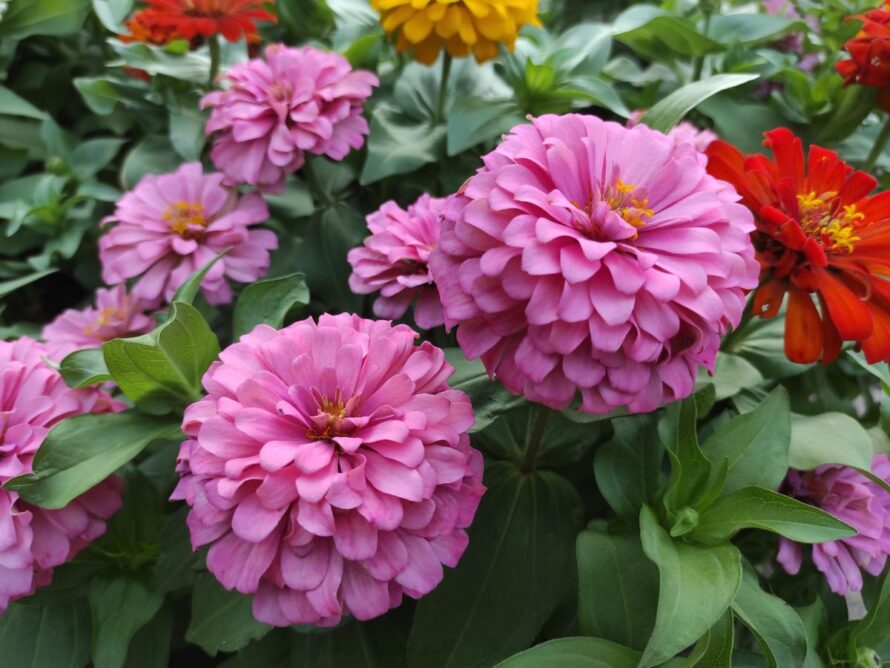
| Flower color: | Pink, Red, Yellow, lilac, purple, yellow, green, white |
| Soil requirements: | Humusy, well-draining |
| Sun exposure: | Full sun |
| USDA growing zones: | N/A (Annual plant) |
| Companion vegetables: | Lettuce, tomatoes, cucumber, beans, potatoes, asparagus |
Zinnia (Zinnia elegans) is a nectar-rich plant that’s a natural magnet for bees and other pollinators. They can also attract birds such as hummingbirds, adding more beauty to your garden.
Paler pastel varieties attract insects such as Japanese beetles and can be used as a trap crop. However, growing a plant that attracts pests like Japanese beetles may pose a risk to the rest of your plants. So, grow this plant when necessary or when solving a particular problem.
Zinnias flowers make great décor for any space, so growing them in your vegetable garden is a great way to have readily available beautiful natural décor. You don’t need to worry about the gaps left behind from the cuttings as the plant regenerates quickly. Besides, gaps are expected in any vegetable garden during harvesting time.
2. Daylily
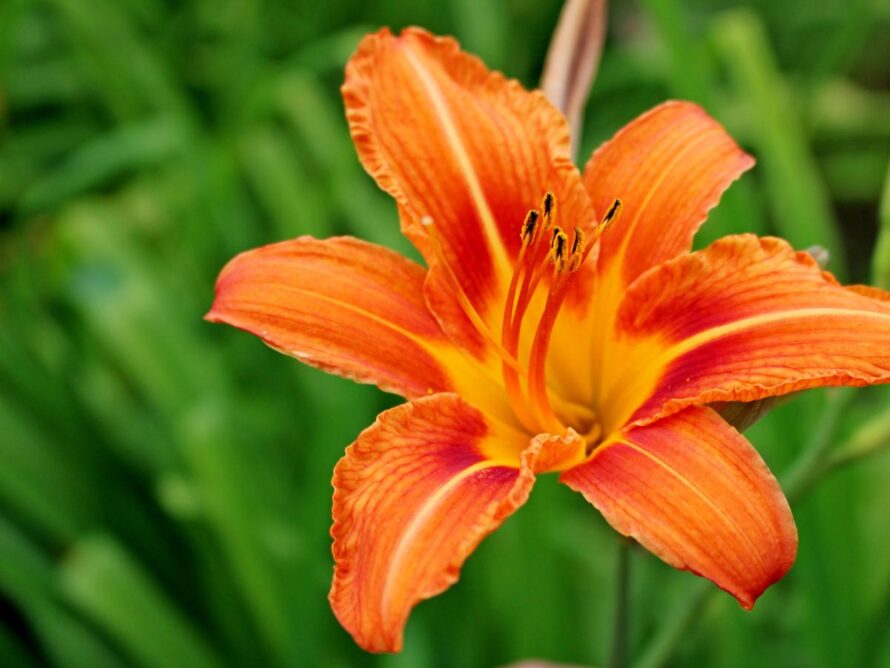
| Flower color: | Orange, red, yellow, purple, pink |
| Soil requirements: | Deep fertile, medium loamy soil (tolerates heavy clay and sandy soil), acidic |
| Sun exposure: | Full sun (can tolerate partial shade/ light woodland) |
| USDA growing zones: | 3 – 10 |
| Companion vegetables: | Tomatoes, carrots, leafy greens such as Swiss chard, kale, mustard green, kale, lettuce |
Daylilies (Hemerocallis spp.) are one of the most popular pollinator-attracting perennials. If they bloom well enough, they also attract hummingbirds to their large open petals. Daylily is a hardy plant that’s easy to maintain and thrives in different conditions.
When added to your vegetable garden, it helps choke out weeds. Since this plant can grow to over 5 feet tall, keep it away from smaller plants, as it can cast shadows over them.
Blooming time is from spring through late summer. The best part about Daylily is that it thrives in full sun and can tolerate slightly dry conditions. Moreover, the plant is relatively pest-free and will be avoided even by rabbits, but it’s a delicacy for deer.
3. Cornflower
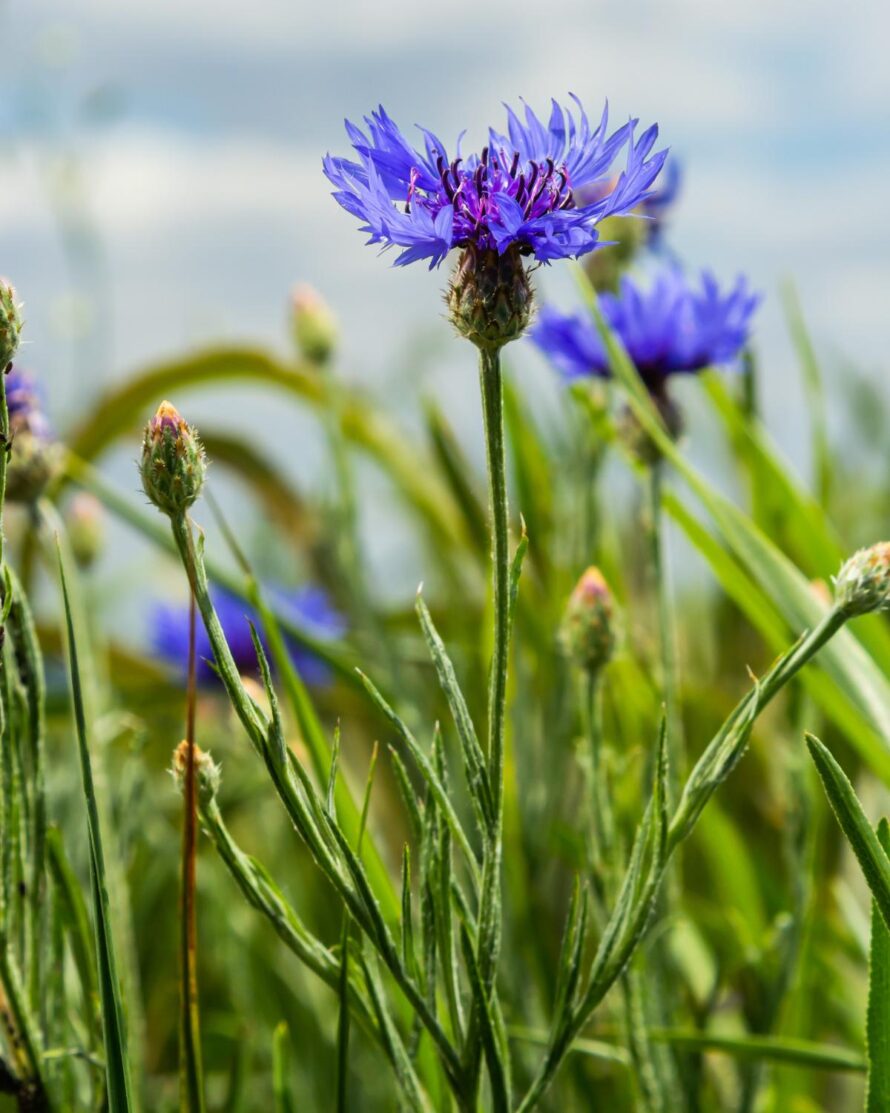
| Flower color: | Purple, blue, pink, red, white |
| Soil requirements: | Moist, well-drained, alkaline |
| Sun exposure: | Full, partial |
| USDA growing zones: | 2 – 11 |
| Companion vegetables: | Tomatoes, beans, corn, butternut squash, basil |
Cornflower (Centaurea cyanus), commonly called the bachelor button, is a beautiful annual that mainly grows as a wildflower, but adding it to your vegetable garden can also help attract various pollinators. The carnation-like flowers of the plant have a deep blue color.
The cornflower makes an attractive choice for your vegetable garden because it’s disease and pest-free. Cornflowers are weeds in grain fields such as barley, rye, wheat, and oats. Even though they are native to Europe, they can be found in many other parts of the world.
Cornflowers bloom for about ten weeks (from May to mid-July). Deadhead spent flowers to increase the plant’s blooming time. This plant’s versatility allows it to tolerate hot summers and light frost.
4. Petunia
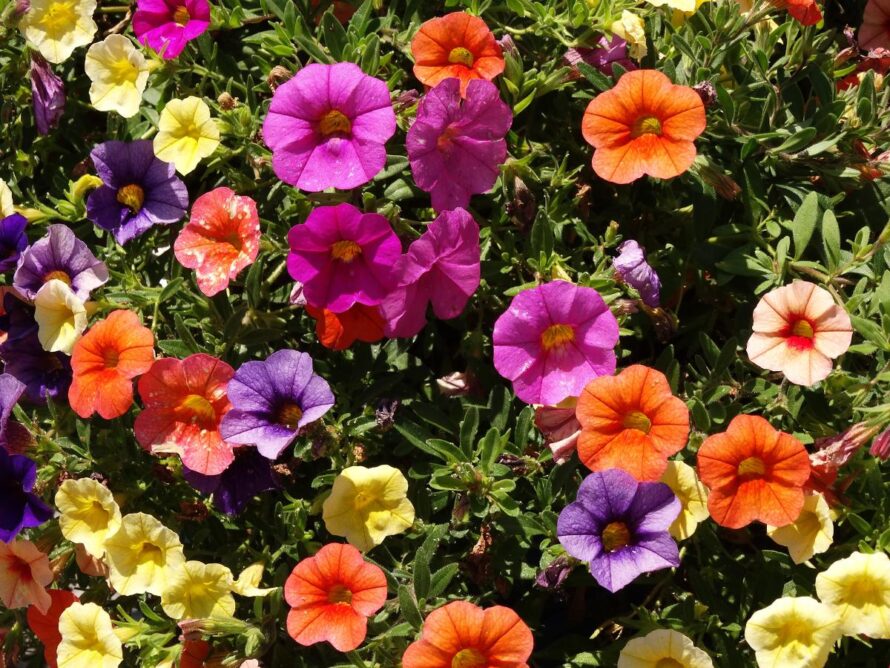
| Flower color: | Purple, pink, yellow, red, orange, white, green |
| Soil requirements: | Moist, well-drained, acidic |
| Sun exposure: | Full sun |
| USDA growing zones: | 10 – 11 |
| Companion vegetables: | Beans, corn, onions, asparagus, tomatoes |
Petunias (Petunia spp.) are trumpet-shaped flowers that are popular not only for their unique shape but also because they repel common garden bugs and pests.
Some of the bugs that are repelled by petunias include asparagus, leafhoppers, Mexican bean beetles, and tomato worms. Petunias are fast-growing annual plants that are especially effective when planted around the perimeter of a vegetable garden.
One of the benefits of growing petunias is that they are easy to care for. As such, you won’t have to worry about their condition constantly. Prune dead flowers to encourage blooming and water the plants continually. Since they can withstand wet conditions, overwatering won’t be a significant issue.
5. Lavender
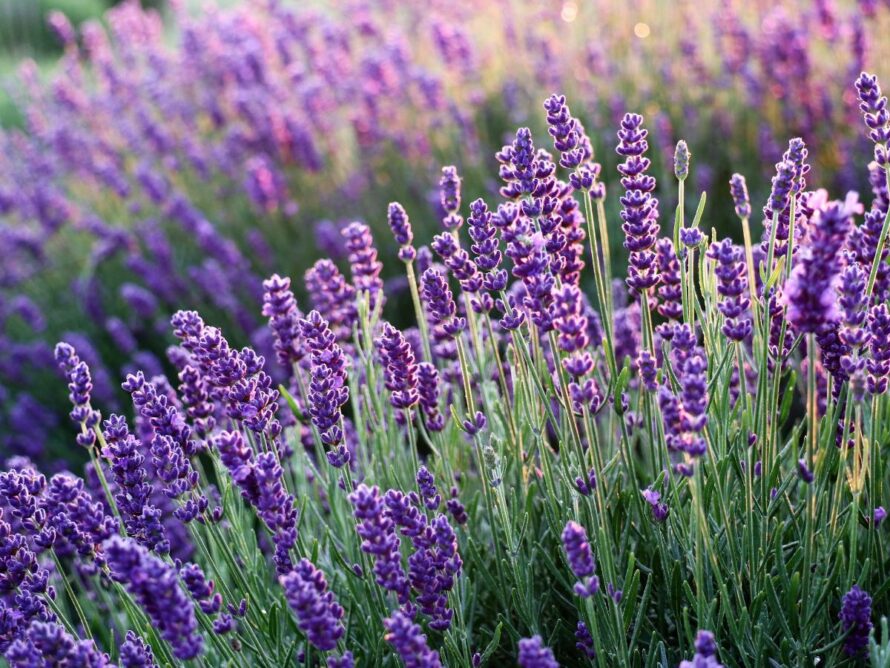
| Flower color: | Violet-blue, purple, rose, pale-pink, white, yellow |
| Soil requirements: | Lean, alkaline, well-draining |
| Sun exposure: | Full sun |
| USDA growing zones: | 5 – 9 |
| Companion vegetables: | Brassicas (such as cabbage and mustard family), lettuce, tomatoes, onions, oregano, squash |
Growing lavender (Lavandula sp.) in your vegetable garden or any garden is always a welcome idea due to the benefits you can get from this plant. In addition to its beautiful flowers and lovely fragrance, this plant helps repel several garden pests and predators.
Animals like deer tend to avoid lavender, which can also deter ticks. Ticks don’t attack plants but can be menacing to you and your pets, and lavender can significantly reduce the number of ticks in your garden space.
Other pests that can be deterred by lavender include moths such as green cabbage moths and sometimes even mice.
6. Sweet Alyssum
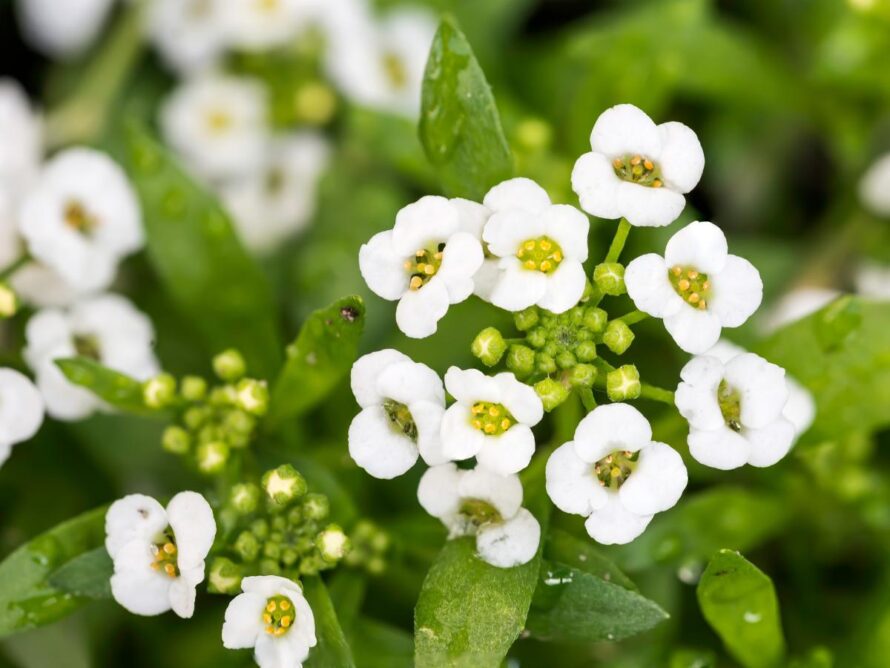
| Flower color: | Purple, pink, white |
| Soil requirements: | Moist, well-drained, neutral or acidic |
| Sun exposure: | Full or partial |
| USDA growing zones: | 5 – 9 |
| Companion vegetables: | Brussel sprouts, cabbage, broccoli, eggplant, potatoes, lettuce |
The tiny, colorful flowers of the sweet alyssum (Lobularia maritima) can create the perfect cover for your garden. This cool perennial makes an excellent addition to any vegetable garden since it attracts beneficial insects like hoverflies and ladybugs that can feed on pests and protect your plants. It also attracts pollinators like butterflies and bees. It’s an excellent two-in-one plant.
It’s easy to care for and can survive in various conditions, including cold temperatures, where it can even bloom. Sweet alyssum spreads provide ground cover and natural mulch for your vegetables.
Other than temperature, this plant can survive in a variety of climatic conditions, including coastal areas and boggy areas with less-than-ideal drainage.
7. Nasturtium
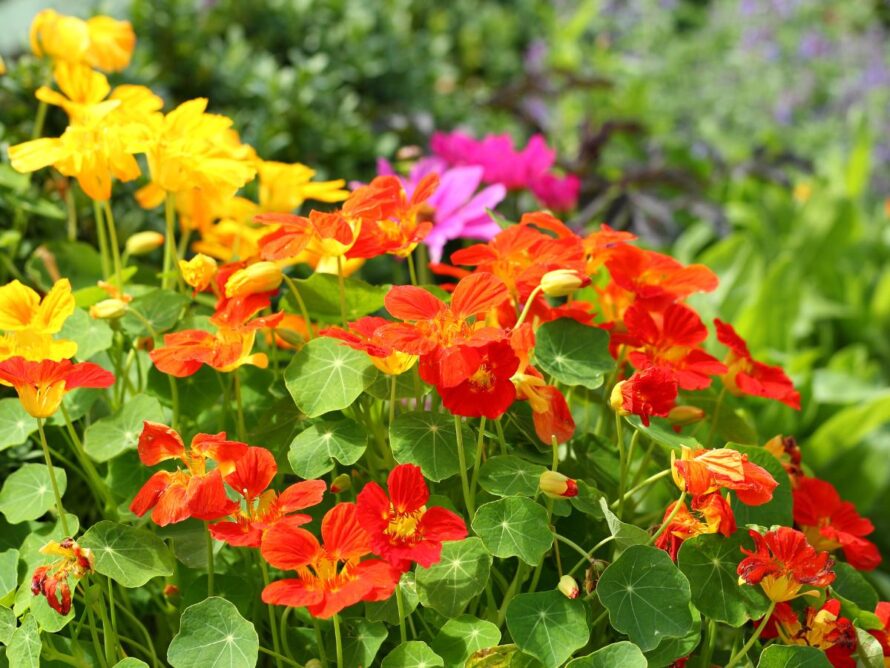
| Flower color: | Orange, red, yellow, and cream |
| Soil requirements: | Slightly acidic, well-draining, poor to average |
| Sun exposure: | Full sun to partial shade |
| USDA growing zones: | N/A (Annual plant) |
| Companion plants: | Brussel sprouts, radishes, cabbage, winter squash, kale, broccoli |
Cheerful nasturtiums (Tropaeolum majus) thrive in cool temperatures and may continue blooming into the fall. Nasturtiums act as natural pest deterrents to squash bugs and beetles.
This plant is also an excellent attraction for aphids; hence, they could trap them and keep your vegetables pest-free. However, they’re also edible, so keep some disease- and pest-free to enjoy later.
The flowers mature and produce large seeds, which are easy to collect and store for the next growing season—some varieties of this plant self-seed. When growing the flower from seeds, first, you need to scarify them by running them with sandpaper or nicking, which will speed up the germination process.
8. Cosmos
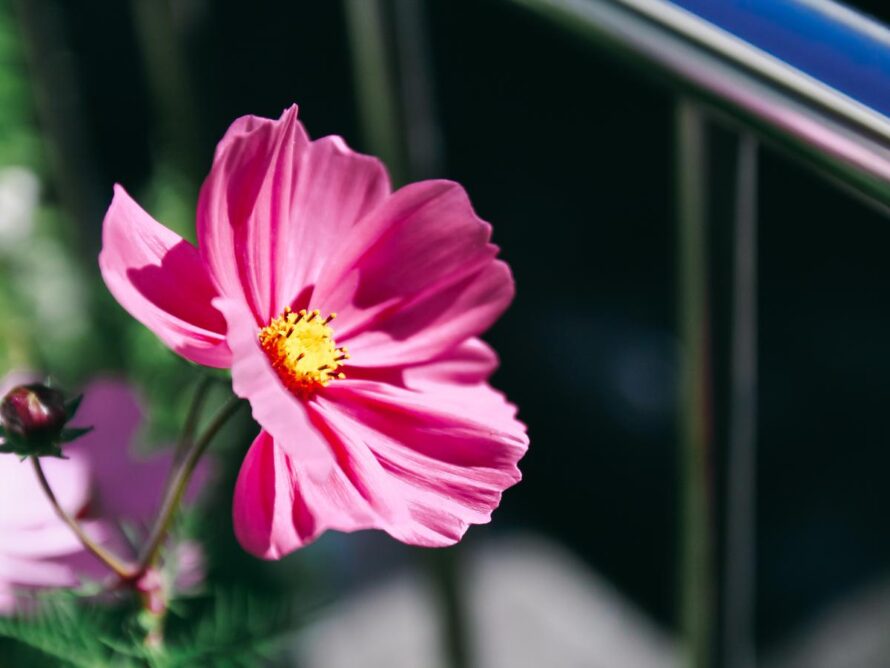
| Flower color: | Pink, red, purple, orange, yellow, white |
| Soil requirements: | Average, with moderate moisture, well-draining |
| Sun exposure: | Full sun |
| USDA growing zones: | 9 – 11 |
| Companion vegetables: | Beets, potatoes, peppers, pumpkins |
Few flowers have as beautiful blooms as the cosmos (Cosmos bipinnatus). These blooms aren’t only attractive to the eyes and attract a variety of helpful insects and pollinators.
The flower color will vary based on the variety, so you can choose the color that best complements your vegetable garden. For example, if you want to attract lacewings, you can use bright orange or white varieties.
Green lacewings are among the most efficient predators of harmful pests that you can introduce to your vegetable garden. These insects consume all kinds of pests, including scales, thrips, and even aphids. They are considered some of the most beneficial insects, so introducing them to your garden is always a good idea since it could prevent pest infestation.
9. Lupine
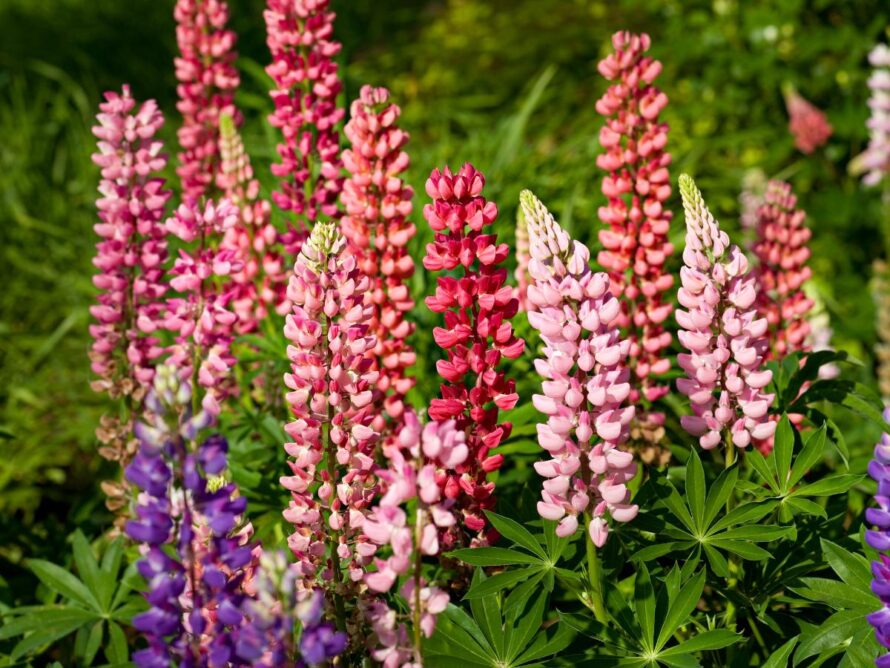
| Flower color: | Pink, yellow, blue, white, purple |
| Soil requirements: | Moist, well-drained, neutral to acidic |
| Sun exposure: | Full sun |
| USDA growing zones: | 4 – 8 |
| Companion vegetables: | Tomatoes, sweet corn, peppers, pole beans, cucumbers, squash, corn, okra |
Lupines (Lupinus x hybrida) produce showy flowers with striking colors. While they’re mainly used in landscaping, they may be an invaluable addition to your vegetable garden. Lupines add to your garden’s aesthetics, and since they are legumes, they can also help with nitrogen fixation in the soil.
While lupine thrives in full sun, it can also tolerate a little shade, primarily when grown in hot climates. Grow this plant in nutrient-rich soil with good drainage; the pH should range from neutral to acidic.
However, ensure the plant isn’t grown in soggy or extremely wet soil, as this could promote root rot. Lupines will do well in cool summers but not in high humidity.
10. Marigold
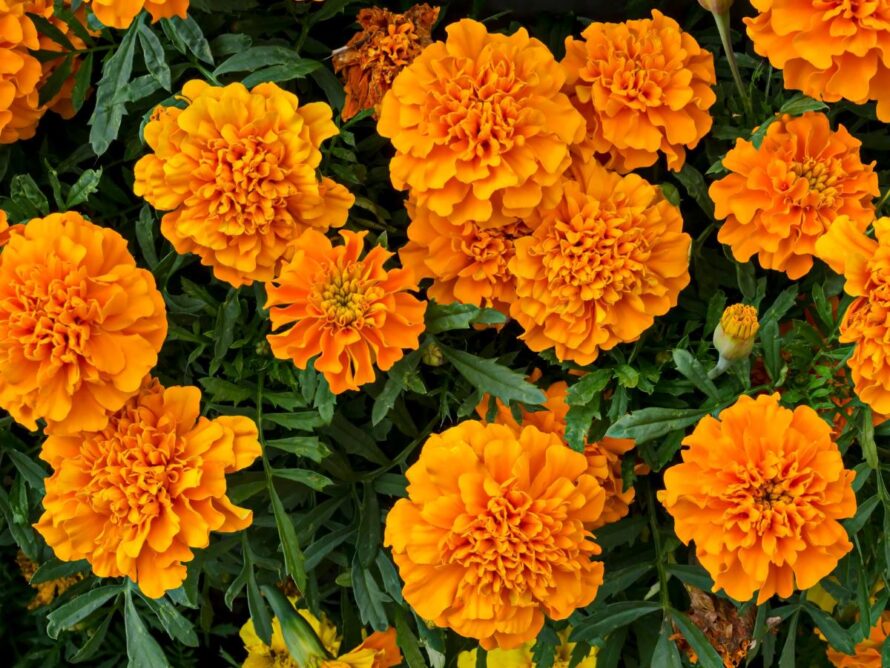
| Flower color: | Red, orange, yellow, gold |
| Soil requirements: | Average, medium moisture, well-draining |
| Sun exposure: | Full sun |
| USDA growing zones: | 9 – 11 |
| Companion vegetables: | Cucumbers, Beans, tomatoes, squash, lettuce |
Marigolds (Tagetes sp.) are among the most underestimated plants in any garden. This is because many people don’t understand the full spectrum of benefits that they can get by growing this flower.
Marigolds head off pests from below and above the ground. The scent of marigolds will put off predators such as rabbits. You can also use marigolds to deter Mexican bean beetles by interplanting them with your bean plants.
Common pests repelled by this flower include thrips, tomato hornworms, squash bugs, and whiteflies. The French marigold (Tagetes patula) variety is also known to secrete a chemical that eliminates root nematodes in the soil.
If your garden has a root nematode problem, leaving the marigold roots in the soil at the end of the growing season is advisable.
11. Sunflower
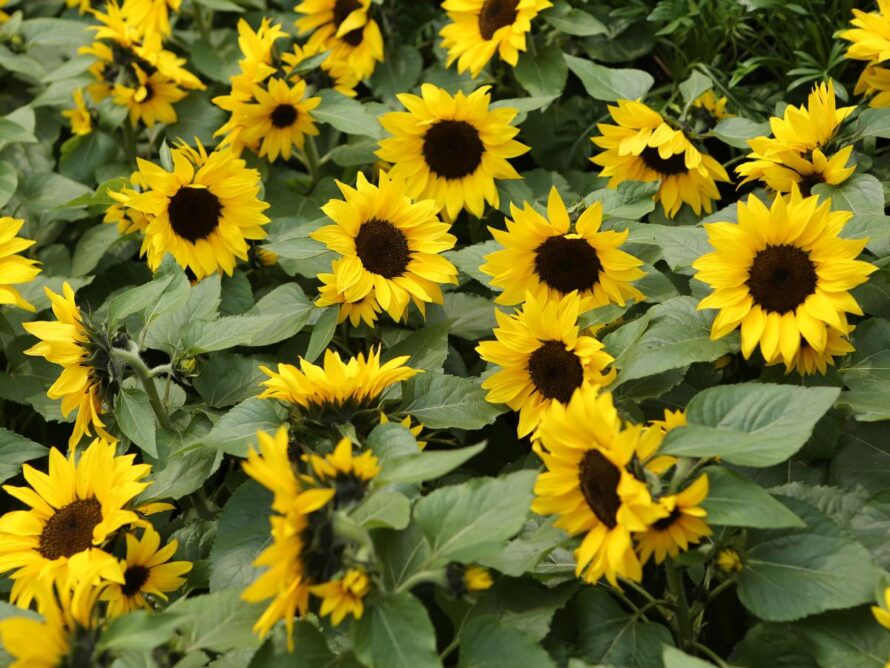
| Flower color: | Yellow, burgundy, red, chocolate |
| Soil requirements: | Average, moist, well-draining |
| Sun exposure: | Full sun |
| USDA growing zones: | N/A (Annual plant) |
| Companion vegetables: | Cucumbers, radishes, onion, corn, tomatoes, squash |
Sunflowers (Helianthus annuus) are among the most vibrant and colorful flowers to add to your vegetable garden. Their height makes them the perfect natural trellis for your vegetables and other climbing plants. The plant’s abundance of nectar also makes it a natural magnet for pollinators.
However, despite their usefulness as a support structure for climbers, sunflowers also tend to attract squirrels. This can be a significant challenge, especially if you’re growing them for the seeds. However, pairing them with coarse-leaved plants like squash can deter predators like squirrels from getting into your garden.
12. Pansy
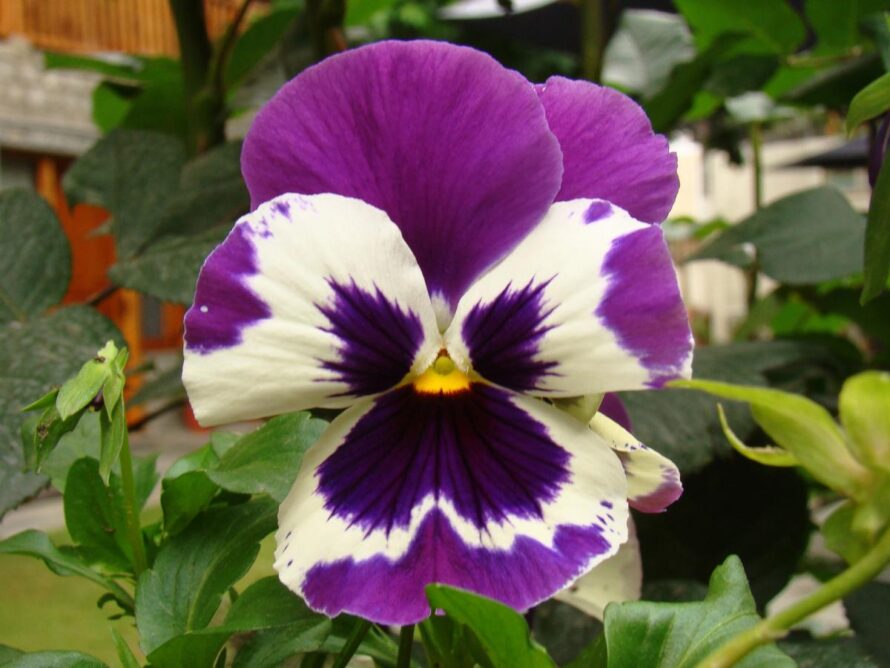
| Flower color: | White, purple, yellow, purple, blue, red, pink |
| Soil requirements: | Acidic, well-drained |
| Sun exposure: | Full, partial |
| USDA growing zones: | 7 – 11 |
| Companion vegetables: | Swiss chard, kale, parsley, cabbage |
The beautiful and adorable pansies (Viola x wittrockiana) that add visual interest and character to your outdoor space can also make an excellent addition to a vegetable garden. In most gardens, pansies are used as cover crops since they grow quickly and retain moisture well.
What’s more, they’re edible. Since using these flowers in the hot season is challenging, you’ll be better suited to growing them as fall-to-spring vegetables. Some variants of pansies can withstand light snow and frost; however, the flowers will die off in winter.
Pansies prefer slightly acidic soil with a pH of 6.0 to 6.2. They should be well watered but not let the soil get soggy or exposed to high humidity.
13. Borage
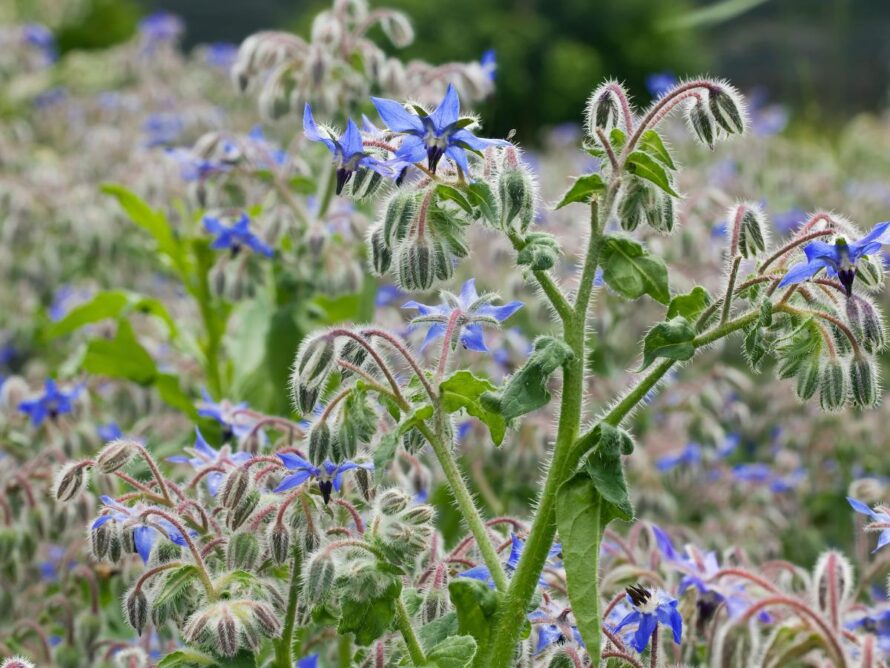
| Flower color: | Pink. blue |
| Soil requirements: | Nutrient-rich, moist, well-draining |
| Sun exposure: | Full sun to partial sun |
| USDA growing zones: | N/A (Annual plant) |
| Companion vegetables: | Squash, tomatoes, cabbage, strawberries |
Borage, known by the scientific name Borago officinalis, is a wide gangly plant that’ll make the perfect addition to a cottage garden. While it can be a bit much to handle when grown in a formal setting, it’s a herb that’ll thrive well in a traditional home vegetable garden.
The plant’s flowers attract bees, so you’ll have a good supply of pollinators. One key advantage of growing this flower is that it makes a great companion plant for tomatoes and squash, so you can grow it as a part of a three-part trio.
Borages are fast-growing, and you can directly grow them on the ground. Even better news is that the leaves and flowers of the plant are edible and have a subtle cucumber flavor. Once it’s grown, this plant will reseed itself.
Flowers from the plant can either be blue or pink. The color variation depends on light, temperature, and other external factors. One of the theories propagated by many gardeners is that the flowers change from pink to blue with age and a decline in pollen production.
It’s presumed that this change of color often indicates that the plant has outlived its usefulness. Plants such as pulmonaria follow a similar concept when aging.
14. Dahlia
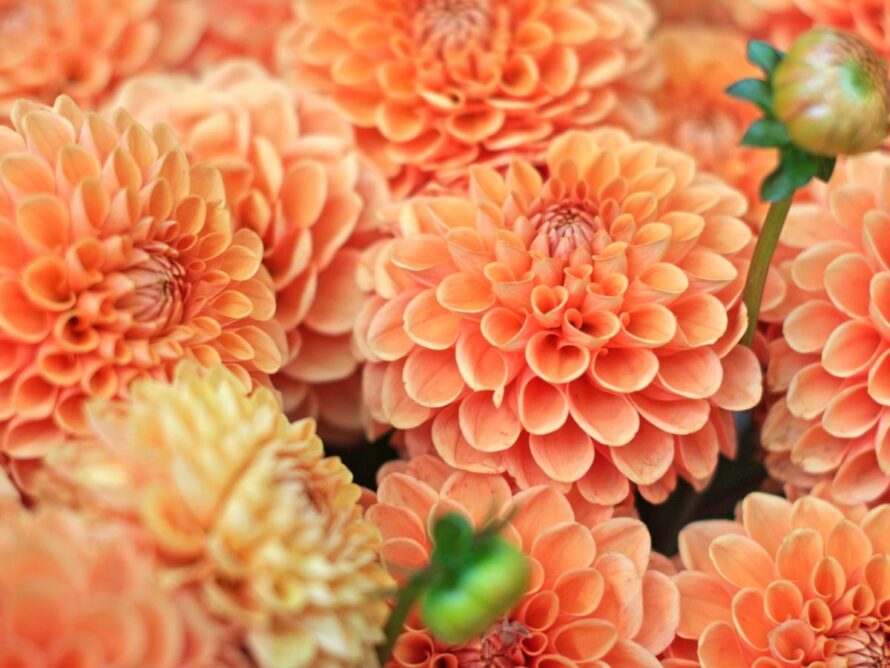
| Flower color: | Pink, orange, purple, white, yellow, red |
| Soil requirements: | Loamy, well-drained, neutral to acidic |
| Sun exposure: | Full sun |
| USDA growing zones: | 8 – 10 |
| Companion vegetables: | Eggplant, beans, squash, peppers, tomatoes |
Dahlias (Dahlia spp.) is a late-blooming plant but compensates for this by having a long-lasting flowering period that may last for as long as three months. It’s a great addition to a vegetable garden since it attracts pollinators, such as butterflies, to help pollinate your vegetables.
However, on the downside, the flowers may also attract pests, so you’ll have to pair it with a bug-repelling plant or flower. Dahlias may grow up to 6 feet, so don’t plant them near smaller plants that may be shaded, which may stunt their growth.
This perennial tuber should be planted in a sunny spot in early spring once the soil has warmed a bit. Ensure the soil around the plant isn’t completely dry, especially on hot summer days.
Dahlia is a heavy feeder that requires frequent fertilization with a phosphorus-rich fertilizer (10-30-20 ratio) to encourage blooming.
15. Pot Marigold
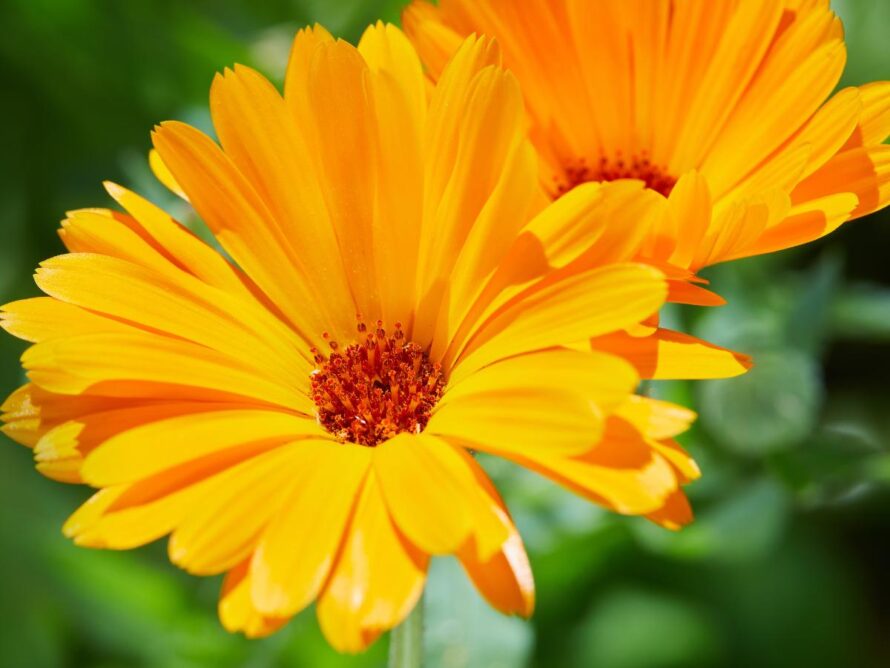
| Flower color: | Yellow, orange, pink, cream |
| Soil requirements: | Rich, slightly acidic to neutral, well-draining |
| Sun exposure: | Full sun to partial shade |
| USDA growing zones: | 9 – 11 |
| Companion vegetables: | Winter squash, cucumbers, tomatoes, carrots, lettuce |
Pot marigolds, or Calendula officinalis, are members of the extensive daisy family. While it may not seem like it, pot marigolds aren’t related to the marigolds from the Tagetes genus.
Despite their predominantly bitter flavor, pot marigolds are considered edible flowers. Their brilliant, bright orange color will liven up your space and your plate.
Calendula has mixed benefits when planted in a garden. On one hand, it repels pests such as asparagus beetles and tomato hornworms. On the other hand, it may attract pests such as aphids.
However, don’t let this little mishap deter you from growing this beautiful flower in your garden since you can use it as a trap plant. To minimize the risk to your vegetables, you can grow the plant away from plants that are susceptible to attacks from aphids, such as peas.
16. Sweet Pea
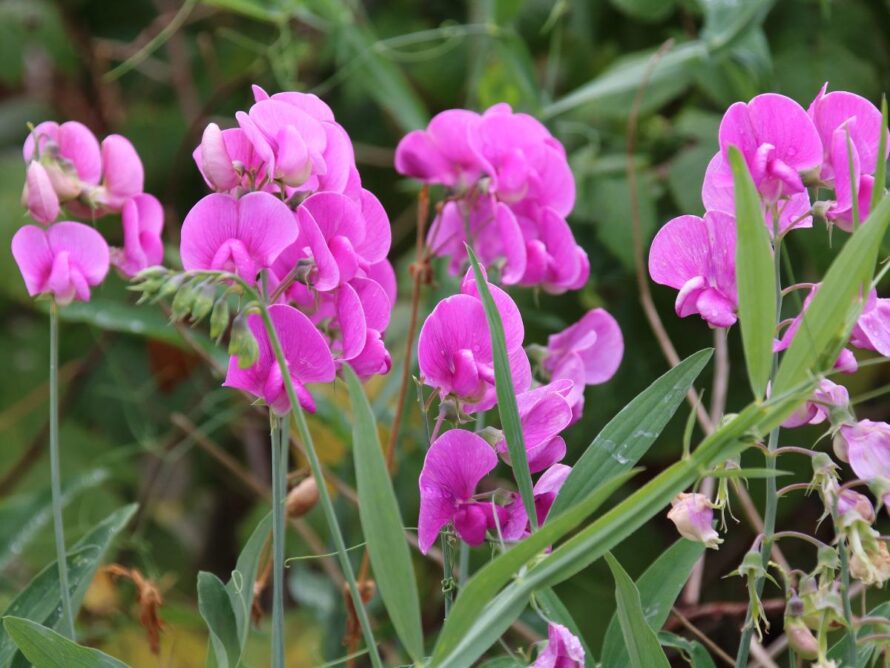
| Flower color: | Red, blue, pink, purple, white |
| Soil requirements: | Humusy, medium moisture, well-draining |
| Sun exposure: | Full sun |
| USDA growing zones: | N/A (Annual plant) |
| Companion vegetables: | Beans, peas, cucumbers, carrots, turnips, spinach |
Even though sweet peas (Lathyrus odoratus) aren’t edible to humans due to their toxic seeds, they’re a delicacy for many other creatures. Growing them in your vegetable garden could help attract beneficial insects that’ll aid pollination.
The best way to maximize sweet peas’ ability to attract pollinators is to grow them with edible peas and pole beans. This way, they will attract pollinators that can fertilize your plants and significantly improve your yield.
Since sweet peas belong to a different genus, they won’t cross-pollinate with your edible variety, so you don’t need to worry about cross-pollination risk.
17. Mums
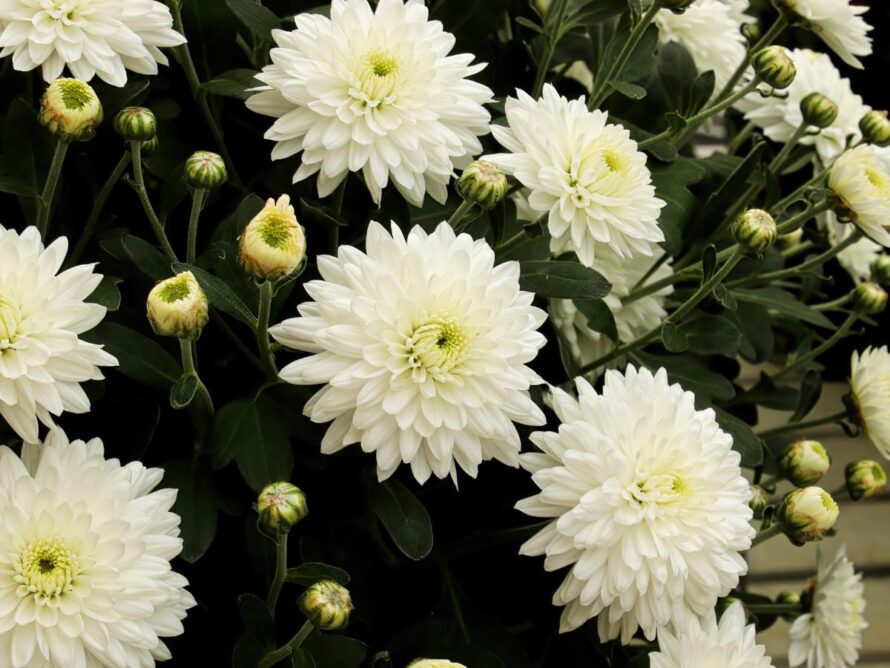
| Flower color: | Yellow, bronze, gold, burgundy, red, pink, lavender, purple, rust, white, cream |
| Soil requirements: | Rich, moist, well-drained, slightly acidic |
| Sun exposure: | Full sun |
| USDA growing zones: | 4 – 9 |
| Companion vegetables: | Pumpkins, tomatoes |
Hardy mums (Chrysanthemum morifolium) are one of the transformative flowers that adorn most porches during the autumn season. If you’re growing a fall vegetable garden, this is just the flower to pair your plants with. Mums primarily help keep pests away.
Pair them with marigolds and petunias to add more protection for your vegetables. They are easy to care for and maintain and will thrive around tomatoes, but like many other vegetables, they thrive under full sun, so there might be some competition.
What Flowers Should Not Be Planted Near Vegetables?
While flowers may add a bit of character and visual appeal to your vegetable garden, ensuring they are compatible with your plants is essential. One of the primary mistakes people make is planting flowers that need compatibility.
Such flowers compete with the vegetables for resources and may sometimes overtake the vegetables. In some cases, they may also attract pests and insects that aren’t beneficial to the plants. Here are some plants to avoid:
- Clover
- Moneywort
- Golden creeping jenny
- Creeping thyme
- Fennel
- Mazus reptans
- Phlox
Commonly Asked Questions
Should I plant perennial or annual flowers in my vegetable garden?
Perennials are the better choice if you plan on planting similar plants each year. If you’re rotating crops, go for annuals.
What plants keep bugs out of vegetable gardens?
Plants like petunias will stamp out bugs like squash, while marigolds may repel cabbage worms. On the other hand, mums will help repel roaches, spider mites, and Japanese beetles.
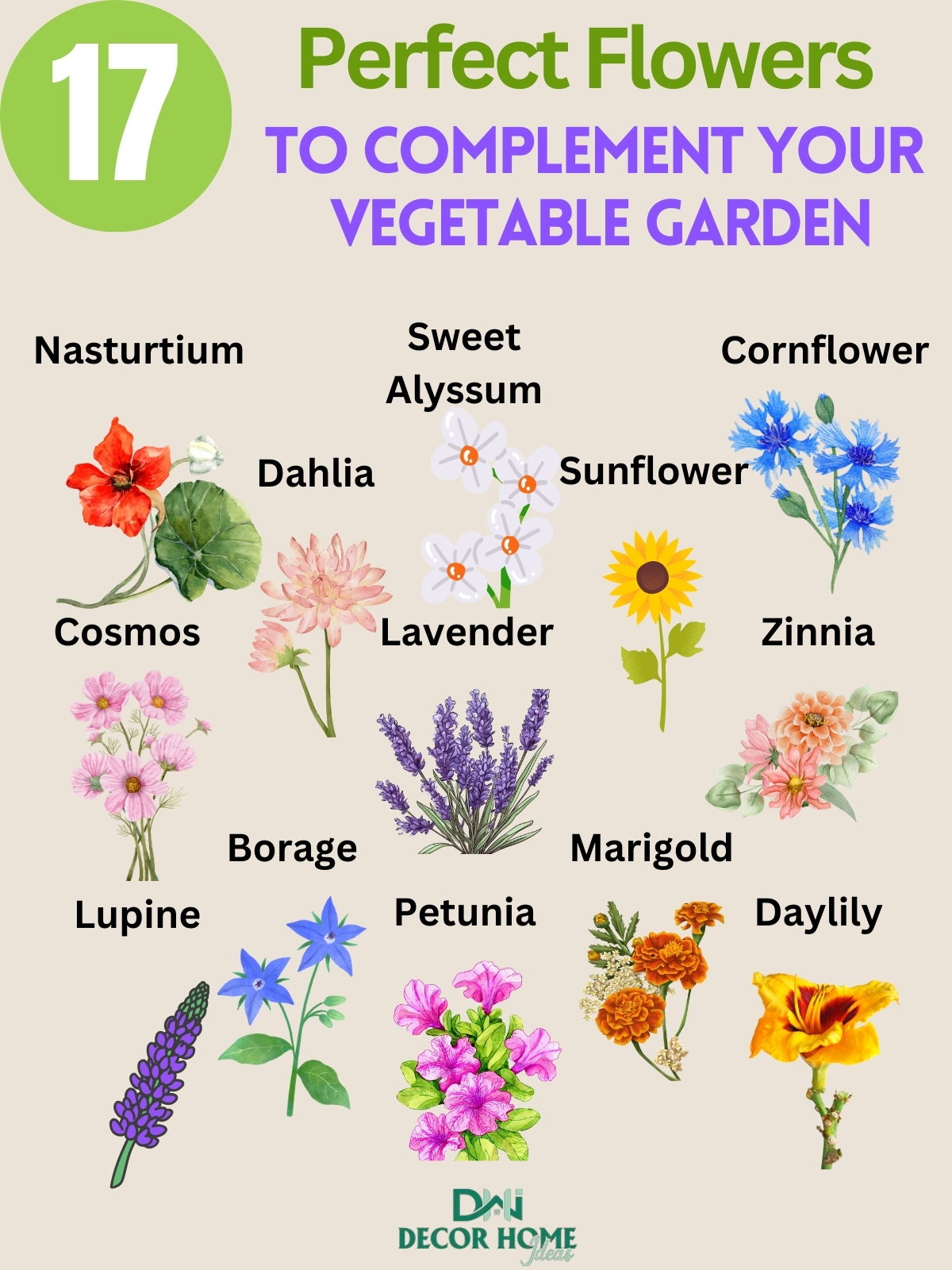
Enhance your vegetable garden with these beautiful flowers that attract pollinators and deter pests.
Marigolds and nasturtiums protect crops from harmful insects, while lavender and sweet alyssum invite beneficial pollinators.
Sunflowers and zinnias add vibrant color, and borage improves soil health.
With cosmos, petunias, and dahlias, your garden will be both productive and visually stunning!


